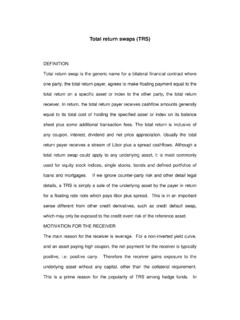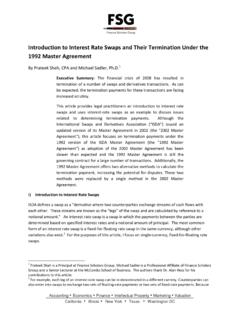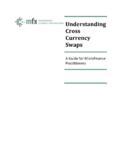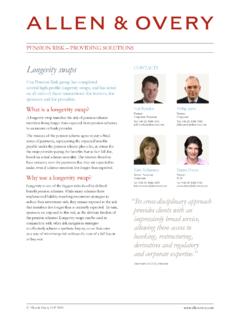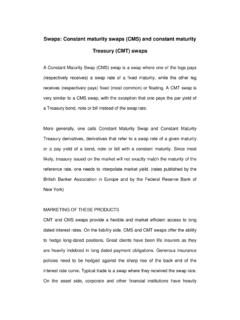Transcription of DIVIDEND SWAPS AND DIVIDEND FUTURES - …
1 Barclays Capital | DIVIDEND SWAPS and DIVIDEND FUTURES 11 October 2010 1 DIVIDEND SWAPS AND DIVIDEND FUTURES A guide to index and single stock DIVIDEND trading DIVIDEND SWAPS were created in the late 1990s to allow pure DIVIDEND exposure to be traded. The 2008 creation of DIVIDEND FUTURES gave a listed alternative to OTC DIVIDEND SWAPS . In the past 10 years, the increased liquidity of DIVIDEND SWAPS and DIVIDEND FUTURES has given investors the opportunity to invest in dividends as a separate asset class. We examine the different opportunities and trading strategies that can be used to profit from dividends. Colin Bennett +44 (0)20 777 38332 Barclays Capital, London Fabrice Barbereau +44 (0)20 313 48442 Barclays Capital, London Arnaud Joubert +44 (0)20 777 48344 Barclays Capital, London Anshul Gupta +44 (0)20 313 48122 Barclays Capital, London Jerome Favresse +44 (0)20 313 48452 Barclays Capital, London Ali Fardoun +44 (0)20 313 48435 Barclays Capital, London DIVIDEND trading in practice: While trading dividends has the potential for significant returns, investors need to be aware of how different maturities trade.
2 We look at how dividends behave in both benign and turbulent markets. DIVIDEND trading strategies: As DIVIDEND trading has developed into an asset class in its own right, this has made it easier to profit from anomalies and has also led to the development of new trading strategies. We shall examine the different ways an investor can profit from trading dividends either on their own, or in combination with offsetting positions in the equity and interest rate market. Contents How different investors can profit from Evolution of the DIVIDEND DIVIDEND TRADING IN PRACTICE 9 How dividends of different maturity 10 How dividends trade in a 14 Membership changes on index 17 DIVIDEND TRADING STRATEGIES 19 Dividends as an alternative to equity.
3 20 Trading DIVIDEND yield .. 21 Trading DIVIDEND spread / growth (steepners) .. 23 dividends with 25 DIVIDEND dispersion 27 Dividends vs interest rates .. 29 Dividends as inflation hedge .. 32 APPENDIX 35 Dividends SWAPS versus DIVIDEND FUTURES .. 36 Which dividends are included .. 38 Why structured products are an overhang on 39 Difference between forwardS and 43 Barclays Capital | DIVIDEND SWAPS and DIVIDEND FUTURES 11 October 2010 2 HOW DIFFERENT INVESTORS CAN PROFIT FROM DIVIDENDS The improved liquidity of DIVIDEND SWAPS and creation of listed DIVIDEND FUTURES has drawn new participants to the implied DIVIDEND market. We estimate that hedge funds and proprietary trading desks still account for 80% of the market; however, we expect this to drop over time as dividends become a more established asset class.
4 We examine the DIVIDEND trading strategies most appropriate for different investors. Different trading techniques appeal to different types of investors Equity investors: As implied dividends usually appear cheap compared with analyst estimates, an investor can replace an equity position with a DIVIDEND position. Should equity markets range trade, then the cheap dividends should still reveal a positive return. For more details, see section Dividends as an alternative to equity . Relative value investors: Investors who are experienced in trading relative value could apply this experience to trading the implied DIVIDEND yield in the equity derivative market. For more details, see section Trading DIVIDEND yield . Macro investors: Macro views can be implemented using dividends for different regions (either naked long or long short).
5 Investors can also trade an anticipated turn in the economic cycle using steepeners. For more details, please read the section Trading DIVIDEND spread/growth (steepeners) . Hedge funds and proprietary trading desks: Hedge funds and proprietary trading desks have historically dominated the client base for DIVIDEND trading. Until the credit crunch, the most common strategy was to trade implied dividends (or DIVIDEND steepeners) naked. However, since the 2008 plummet of implied dividends, many investors sought to protect against the downside risks that were previously held either by hedging an index DIVIDEND position with a put option or by selling single stock dividends in sectors with regulatory risk (eg, Financials). For more details, see section Hedging dividends with options and DIVIDEND dispersion trading.
6 Interest rate investors: Empirically, there is a relationship between DIVIDEND yield and interest rates. An investor who would normally invest in the rates market could consider investing in DIVIDEND yield instead and benefit from the cheapness in the implied DIVIDEND market. More details of the correlation between dividends and interest rates can be seen in the section Dividends vs interest rates . Investors concerned about inflation: For more than 100 years, DIVIDEND payouts for the UK and US have risen in line with inflation. DIVIDEND payouts have the same advantage as equities as an inflation hedge, but with a lower volatility. For more details, see section Dividends as inflation hedge . Money market/short-term yield investors: Investors with a very short time horizon could consider near-dated implied dividends (maturity less than a year) as dividends become a cash basket during Q2 of their year of expiry (as majority of dividends would have been announced).
7 As there is usually a pull to realised in Q3 of the year preceding maturity, short-term yield investors could consider dividends of maturity circa one year. For more details, please see the section How dividends trade in a crisis . Barclays Capital | DIVIDEND SWAPS and DIVIDEND FUTURES 11 October 2010 3 EVOLUTION OF THE DIVIDEND MARKET From the difference in price between a stock and its forward (or future ), it is possible to calculate the value of an unknown DIVIDEND implied by the FUTURES market (the implied DIVIDEND ). There are three main methods an investor can use to trade an implied DIVIDEND : 1) near-dated dividends can be traded through an Exchange For Physical (EFP); 2) to trade dividends between two dates, an investor can use forwards/ FUTURES , yet they will have to hedge their interest rates risk as well; 3) the simplest method is DIVIDEND SWAPS / DIVIDEND FUTURES , which give pure DIVIDEND exposure.
8 1) EFP (Exchange For Physical) A forward (or future , its listed equivalent) is the most simple equity derivative. As it is an agreement to exchange a security at a specified date in the future (at a price and location agreed today), the owner of the forward does not get any of the benefits of owning the security until the expiry date. This means the owner of a forward on a stock or index does not receive any dividends between now and expiry. Ignoring the effect of interest rates or repo (or assuming these are hedged), the price of a share and its forward will move in tandem. Hence, if an investor has a long stock and short forward position, the combination should only be exposed to the value of the implied DIVIDEND embedded in the forward price (and interest rates and repo which we shall assume is hedged).
9 This position is established by selling the Exchange For Physical (EFP). The reverse trade (short stock and long forward), or buying the EFP, can be initiated if an investor wants to short implied dividends. A useful rule is that a long forward position is a short DIVIDEND position Figure 1: How implied DIVIDEND value can be calculated from spot and forward price 8890929496981001020 10203040506070809010 DaysStock price ( )0 Implied dividendPrice falls by DIVIDEND amount on ex-dateDividend ex-dateForward (excludes DIVIDEND )Spot (includes DIVIDEND ) Source: Barclays Capital EFP allows near-dated dividends to be traded The price of an EFP is quoted in terms of the basis between the forward and spot (a positive price implies that the forward is trading above cash). If the implied DIVIDEND rises in value, the value of spot remains unchanged while the forward price declines.
10 As selling the EFP is short the forward, it earns a profit (as expected because the position is long implied dividends, which have increased). An EFP therefore captures all dividends whose ex-date is between the trade date and the expiry of the forward and, hence, allows near-dated dividends to be traded. Barclays Capital | DIVIDEND SWAPS and DIVIDEND FUTURES 11 October 2010 4 EFP are normally used to trade known dividends A typical maturity for an EFP is three months. As near-dated dividends have usually been announced, and are therefore known, trading unknown implied dividends via an EFP is not as practical as other methods. One motivation for trading known dividends through an EFP is the different tax treatments of different investors. 2) Forward/ FUTURES (or synthetics) A forward is a contract to buy (or sell) a quantity of an underlying security at a specified price (or strike) on a specified maturity.


